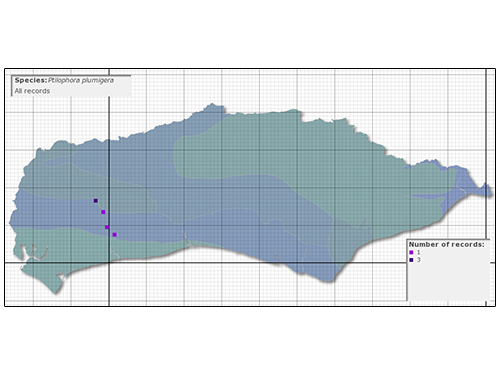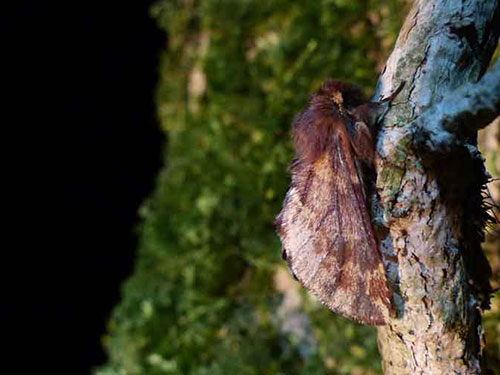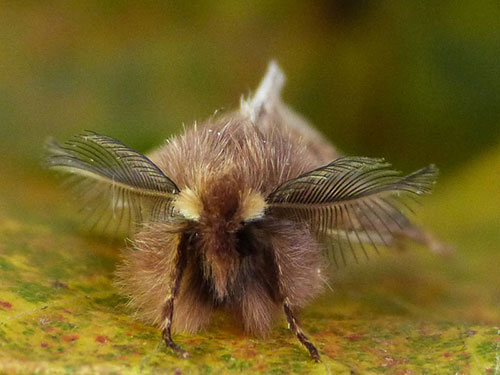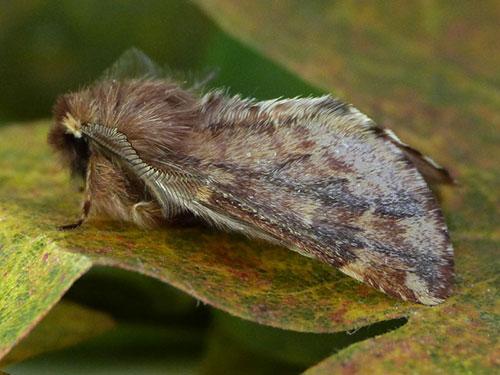


Map showing the slither of West Sussex where all the recent records of Plumed Prominent have occurred
Source: sussexmothgroup.org.uk / SxBRC

A male Plumed Prominent at rest beneath a large Field Maple on the scarp slope of chalk downland at Duncton
Photo: Dave Green

Male Plumed Prominent showing its incredible strongly bipectinate antennae and very hairy thorax
Photo: Dave Green

Male Plumed Prominent showing its beautiful patterned wings
Photo: Dave Green
There are around 2,000 moth species resident in Sussex, and of the larger species the Plumed Prominent, Ptilophora plumigera is one of the very hardest to find. Some moth species are scarce and some species are seriously under-recorded; to see them one has to go out at unsociable hours and stand around in inclement weather, or the species may simply not be attracted to light traps. The Plumed Prominent appears to be both rare and seriously under-recorded as this enigmatic species flies at a time of year when most moth trappers have put away their generators and light traps for the winter, and it appears to often ignore the lights of the traps.
The Plumed Prominent is a resident species which is classed as National Scarce A, and is found very locally in the south-east of England from Dorset to Kent, and north to Gloucestershire, Buckinghamshire and Suffolk. In Sussex it has only ever been found in West Sussex in its specialist habitat of woodland with mature Field Maples on the calcareous soils of the scarp slope of the downs.
The ‘Prominent’ in the Plumed Prominent’s name comes from the larvae of many species in its family which have prominent lobe-like projections on their backs (although these are absent in this species), and the ‘Plumes’ relate to the male’s incredible antennae. It is also known as the Bonfire Night Moth due to its emergence around the 5th November, an unusually late flight period for a Prominent Moth.
The larvae feed on Field Maple, Acer campestre (and perhaps occasionally Sycamore, Acer pseudoplatanus) and it is on these trees that the females lay their eggs during their flight season throughout November. The eggs are carefully deposited on a twig of the foodplant and overwinter in that state, with the larvae hatching in late April and feeding through to July. At that point the larvae descend from the tree and pupate in a brittle cocoon amongst the leaf litter, before emerging as adults in November.
In West Sussex the species has only ever been know from the deciduous woodland on the north slope of the Downs between Duncton and North Stoke, although wandering individuals caught in Arundel in 2013 and 2014 may be indicative of the colonisation of new areas of woodland further to the south.
The Plumed Prominent evaded capture in Sussex for 14 years from 1998, before being recorded again on 8th November 2012 when three males were caught at Duncton. Well known for its disappearing acts, this species can go unrecorded for sustained periods of time before turning up in traps again; in Hampshire it has not been recorded since 1984 but it is felt it is likely to still be resident as its habitat is little changed! Luckily, when running light traps to record this species if Plumed Prominents haven’t turned up by 9:00pm you know you can pack up and head home; the male Plumed Prominent flies early on in the evening with the females coming out much later at night and being less likely to come to light.
Your best chance of encountering this enigmatic species in West Sussex is to find a woodland site on the scarp slope of the downs with plentiful mature Field Maple which is also reasonably close to the existing populations. During November the Field Maple’s leaves usually change to a glowing orangey yellow colour which is incredibly vibrant and helps pick out the trees amongst other species. Once a site has been selected you should run a moth trap there from dusk until around 9pm on a reasonably warm and still evening, and if you are very lucky you may attract in a Plumed Prominent or two.
The only other likely ways you could record this species would be to catch a wandering adult in your garden moth trap, or potentially finding the larvae when beating mature Field Maple for insects from May through to July. If you are lucky enough to find a Plumed Prominent please submit your record to bobforeman@sussexwt.org.uk at the Sussex Biodiversity Record Centre or enter it on iRecord.
Dave Geen, Chair, Sussex Moth Group
Every month it is our aim to highlight a species that is “in-season” and, although not necessarily rare or difficult to identify, has been highlighted by our local recording groups as being somewhat under-recorded and for which new records would therefore be welcomed.
If you or your recording group are aware of species such as this then please contact Bob Foreman.